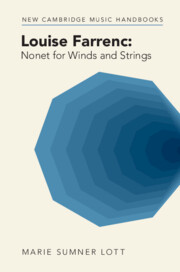Refine search
Actions for selected content:
121 results
4 - Civic Government
-
- Book:
- Empire of Fear
- Published online:
- 27 November 2025
- Print publication:
- 11 December 2025, pp 150-188
-
- Chapter
- Export citation
10 - This Is Still a Democracy, Isn’t It? (1973–1975)
-
- Book:
- Waging Peace
- Published online:
- 03 November 2025
- Print publication:
- 13 November 2025, pp 394-407
-
- Chapter
- Export citation
9 - The 2016 Seine River Flood and Its Impacts to the Paris Sanitation System and on the River’s Water Quality
-
-
- Book:
- Impact of Urban Floods on Water Quality
- Published online:
- 23 October 2025
- Print publication:
- 06 November 2025, pp 109-127
-
- Chapter
- Export citation

Louise Farrenc: Nonet for Winds and Strings
-
- Published online:
- 23 October 2025
- Print publication:
- 23 October 2025
1 - Cultivating an Audience for Chamber Music in 1840s Paris
-
- Book:
- Louise Farrenc: Nonet for Winds and Strings
- Published online:
- 23 October 2025
- Print publication:
- 23 October 2025, pp 23-57
-
- Chapter
- Export citation
Introduction to the Life and Career of Louise Farrenc
-
- Book:
- Louise Farrenc: Nonet for Winds and Strings
- Published online:
- 23 October 2025
- Print publication:
- 23 October 2025, pp 1-22
-
- Chapter
- Export citation
6 - The Focal Transcultural Ethnography
- from Part II - Transcultural Ethnography
-
- Book:
- Ethnography in International Business
- Published online:
- 21 October 2025
- Print publication:
- 09 October 2025, pp 146-165
-
- Chapter
- Export citation
Chapter 3 - Crafting a Style
-
- Book:
- The Cambridge Introduction to Ernest Hemingway
- Published online:
- 15 September 2025
- Print publication:
- 02 October 2025, pp 31-63
-
- Chapter
- Export citation
Introduction
-
-
- Book:
- Ockham’s <i>Summa Logicae</i>
- Published online:
- 04 September 2025
- Print publication:
- 18 September 2025, pp 1-18
-
- Chapter
- Export citation
Chapter 1 - Havana and New York City
- from Part I - Places and People
-
-
- Book:
- María Irene Fornés In Context
- Published online:
- 27 August 2025
- Print publication:
- 07 August 2025, pp 3-13
-
- Chapter
- Export citation
Chapter 2 - Paris
- from Part I - Places and People
-
-
- Book:
- María Irene Fornés In Context
- Published online:
- 27 August 2025
- Print publication:
- 07 August 2025, pp 14-23
-
- Chapter
- Export citation
Chapter 10 - Carmen Collado Fornés
- from Part I - Places and People
-
-
- Book:
- María Irene Fornés In Context
- Published online:
- 27 August 2025
- Print publication:
- 07 August 2025, pp 101-112
-
- Chapter
- Export citation
Chapter 35 - Remembering Pierre
- from Part VII - Legacy
-
-
- Book:
- Boulez in Context
- Published online:
- 08 July 2025
- Print publication:
- 24 July 2025, pp 363-369
-
- Chapter
- Export citation
Chapter 28 - The French Stage
- from Part IV - Performance Legacies
-
-
- Book:
- Sean O'Casey in Context
- Published online:
- 23 June 2025
- Print publication:
- 10 July 2025, pp 308-317
-
- Chapter
- Export citation
The Counting Machinery: Translation, Multiplication, and Liberal Politics of Homelessness in Paris
-
- Journal:
- Signs and Society / Volume 13 / Issue 3 / September 2025
- Published online by Cambridge University Press:
- 08 July 2025, pp. 431-453
-
- Article
-
- You have access
- Open access
- HTML
- Export citation
17 - Jews in Armed Resistance Movements and Partisan Units
-
-
- Book:
- The Cambridge History of the Holocaust
- Published online:
- 16 May 2025
- Print publication:
- 12 June 2025, pp 281-299
-
- Chapter
- Export citation
5 - ‘The Challenges of New Markets’
-
- Book:
- The European Art Market and the First World War
- Published online:
- 10 April 2025
- Print publication:
- 17 April 2025, pp 182-203
-
- Chapter
- Export citation
1 - The European Market before 1914
-
- Book:
- The European Art Market and the First World War
- Published online:
- 10 April 2025
- Print publication:
- 17 April 2025, pp 11-65
-
- Chapter
- Export citation
Dalliance with Ho Chi Minh: Komatsu Kiyoshi in Paris and Hanoi
-
- Journal:
- Asia-Pacific Journal / Volume 19 / Issue 7 / April 2021
- Published online by Cambridge University Press:
- 14 March 2025, e3
-
- Article
-
- You have access
- Open access
- Export citation
7 - Paris
-
- Book:
- Lawyering Imperial Encounters
- Published online:
- 19 December 2024
- Print publication:
- 02 January 2025, pp 179-203
-
- Chapter
- Export citation
